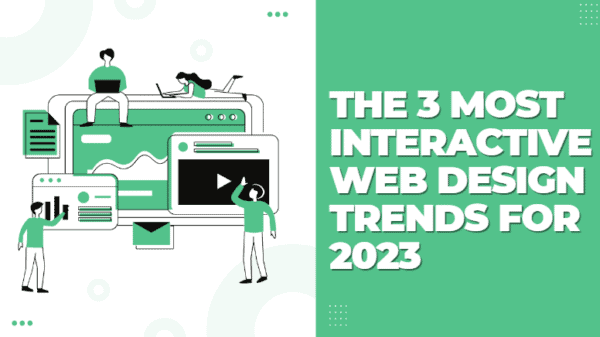There are many variations on the design process that designers use when creating user interfaces for websites. Over time, designers tend to work into a process that is effective for them and their style. Regardless of the steps, designers typically have similar goals when it comes to web design as they typically want to create attractive designs that target an appropriate audience in a way that is consistent with branding standards.
These days, there is a focus on ease-of-use and it is with good reason because in today’s market the effectiveness of a website is often the result of one key factor: user experience.
Right now, user experience or customer satisfaction is critical to succeeding. Modern websites need to be easy-to-use, in addition to being useful for visitors. Many of your website’s visitors will have spent 20 years looking at websites at this point and their tastes have become more refined over time. No longer are website visitors willing to stumble through a poor user experience.
Because of this, your user interface design process should be focused on increasing the usability of the website. The right workflow can be a key component in helping you achieve that goal. Work with these steps and adapt them to your style and they can help you create extraordinary web experiences.
Define the project
A company’s website can be its face to the world. Very regularly, potential customers will look at a website before choosing to do business with a company. In fact, in a 2014 study by Acquity Group, a stunning 94% of business buyers stated that they do online research prior to making a purchase.
Before you start designing, it is important that you have an understanding of why a customer visits the website. Define what the goals are for a website before working on the visual layout. Both the goals of the organization and the goals of customers who visit the website are important to understand going in. This will help you determine which approach to use when telling visitors who this business is and what they offer.
Talk to the customer
Remember that people will visit this website with a goal in their mind. They want to do something, such as learning about the company or their products or perhaps to just go ahead and make a purchase. When it comes to websites, they often fail by not giving customers what they are looking for. Develop an understanding of what the customer is looking for so you know what to give them.
For example, there are specific pieces of information that customers traditionally will look for on their purchase journey. If you fail to provide them with the proper information, it will leave visitors unsatisfied and prevent them from forming an adequate understanding of what the business has to offer. These may vary industry by industry or product by product but you need to understand what information is appropriate to provide to assist in their decision-making process.
Plan ahead to facilitate visitor tasks
You should proceed with the goal of helping website visitors easily find what they are looking for. A good website interface is more than just attractive, it facilitates visitors completing the tasks they came to the website for simply and quickly. After you know what visitors are looking for, you want to plan on making their path an easy one.
At the heart of this is your website’s navigation. Use thoughtful planning of the information architecture and navigation to create an easy-to-understand and easy-to-use navigation system for the website. It should allow visitors to complete tasks as simply and easily as possible. Try to be clear and concise with navigation text and make buttons/links obvious so users don’t have to hunt for them.
Utilize wireframes
If you are not yet using wireframes, the time to start is right now. If you are like me, you probably feel like you know what you are doing and that you don’t need them. But the fact of the matter is that wireframes serve a valuable purpose and should not be seen as a waste of time. First and foremost, when designing wireframes you are using a different thought process focused on the data and user experiences rather than being distracted by design considerations. This allows you to focus on some key issues that are important to the success of the website.
Wireframes are a great tool to aid in clarifying communication between you and your client without your client being distracted by design. Sometimes clients can be distracted by how attractive designs are and miss critical pieces of information. Once you have agreed on a set of wireframes with your client, you can then focus on a visual design that enhances the wireframe layout.
Prototype and test
These days we have access to wonderful tools that we can use to turn wireframes into prototypes, allowing clients and testers to examine and point out problems in the wireframes during the early stages of a project. This allows you to correct issues before you get to high-fidelity designs or development. You can create clickable wireframes utilizing a tool such as InVision. This allows you to test this early prototype live within your team or with sample users from the target audience and revise as needed.
Prioritize content
When a visitor arrives at a website it is for a reason, maybe it’s to gather information about a business or product, read the news, socialize or shop. It is important that you prioritize this content rather than focusing on graphic-heavy designs that do nothing to help visitors accomplish their goals. Put the visitor’s reason for being there front and center rather than trying to showcase your design skill.
It is important that you know how to write for websites and format that content for online consumption patterns as well. People don’t read websites the way they read a book, magazine or newspaper; rather they scan, checking out headlines, looking for keywords and review lists. If they see a headline that perks their interest, they will read the content under it.
To cater to the way that modern website visitors read, you should format your content to fit this behavior, utilize lists, highlight keywords, write using short paragraphs and avoid jargon, stick with simple, concise messages that are easy to read and understand. Empathize with website visitors to determine what message you should share with them, remembering that effective communication is a primary goal for the website.
Use design to enhance the experience
Visual design is an important part of any website design. It can create delight and spark interest in a website. As a designer, this is often the most enjoyable part of the process as you are able to get your hands dirty creating something wonderful. Perhaps you have the chance to use a new trick or style you want to use. There is no denying that positive feedback on design work is a great feeling.
Remember, though, that your goal is to create an effective website and not to show off your design skill. Often efforts to show off design skill get in the way of positive user experiences. First and foremost, you want to create a website with a great user experience and your design work should help facilitate that. Pay attention to the details, micro-moments are an important part of modern design and spending the extra time on them can enhance a website’s success.
Keep in mind that over time most of us have stopped paying attention to ads online. Avoid designing elements that look like ads as they will just be ignored by users. Don’t forget to use white-space in your design; whitespace is an essential part of a great design. It will make your content more legible and help visitors focus on key elements when properly used.
Pay attention to feedback
Great user experiences tend to change subtly over time with small improvements being made here and there. Plan ahead on how you will manage the feedback process. To improve user experiences, you need to empathize with the target audience. You want to be careful to pay attention to the details when they do give you feedback as well. These can be worth their weight in gold if you utilize the feedback to improve your user interface.
You should have a goal to make the user experience better over time. How can you make it more intuitive or more relevant? The website’s visitors will have the answer. After your design is programmed and launched, pay attention to the metrics and make adjustments to work to improve conversion and user engagement. The launch of your design should be seen as a starting point for a long-term conversion and engagement strategy.
Kimber Johnson is the co-founder of ASPEN App Design, which is a sister company of Vanity Mobile Apps and Pacific App Design. He has worked within the web development, graphics design, mobile application development, marketing and advertising fields for over 17 years.

1 Comment
Leave a Reply
Cancel reply
Leave a Reply
This site uses Akismet to reduce spam. Learn how your comment data is processed.






















































































































































































Sagar Nandwani
February 24, 2017 at 7:58 am
Hey, thank you for blog. This blog is amazing really informative and easy to understand. I have my own website I know hoe important it is to maintain the creativity and on regular basis we need to update it. Thanks for sharing your knowledge.